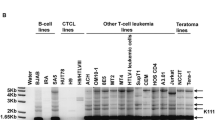Summary
A new family (HERV-W) ofhuman endogenous retroviruses (HERVs) has recently been described that is related to MSRV (multiple sclerosis related retrovirus) sequences that have been identified in particles recovered from monocyte cultures from patients with multiple sclerosis. We investigated the pol fragment of HERV-W on the human X chromosome by the polymerase chain reaction (PCR) using a monochromosomal somatic cell hybrid DNA panel and compared these with related sequences in the genome database. We identified three novel sequences on the human X chromosome, HWXI, HWX3, and HWX5, which have a high degree of homology (88–98%) with the MSRV pol fragment and with seven other sequences. HWX5, like MSRV, has an uninterrupted open reading frame. Phylogenetic analysis showed HWX5 to be related to the HWX1, HWX3, and BAC clone B353C18 sequences with 91–93% homology. The ratio of synonymous to nonsynonymous substitutions indicated that negative selective pressure is acting on HWX5. Further studies on the structure and expression of this sequence are indicated.
Similar content being viewed by others
Author information
Authors and Affiliations
Additional information
Received February 8, 1999/Accepted July 13, 1999
Rights and permissions
About this article
Cite this article
Kim, HS., Crow, T. Identification and phylogeny of novel human endogenous retroviral sequences belonging to the HERV-W family on the human X chromosome. Arch. Virol. 144, 2403–2413 (1999). https://doi.org/10.1007/s007050050653
Published:
Issue Date:
DOI: https://doi.org/10.1007/s007050050653




